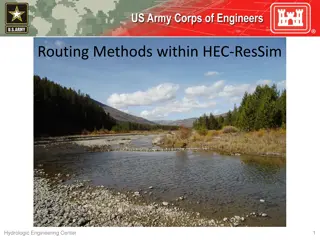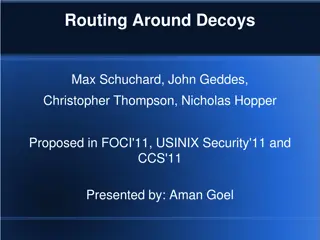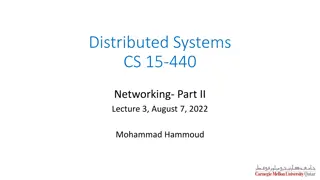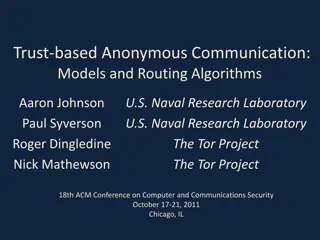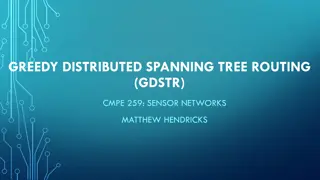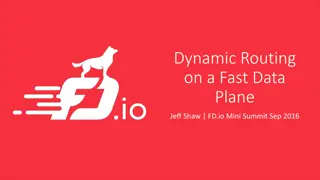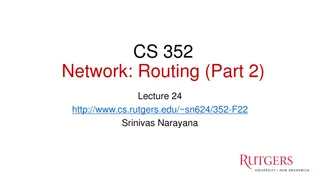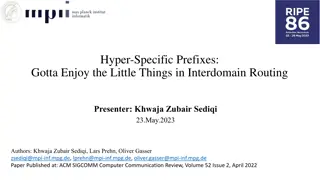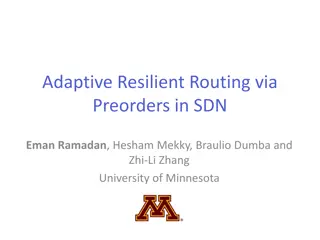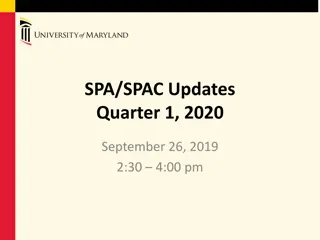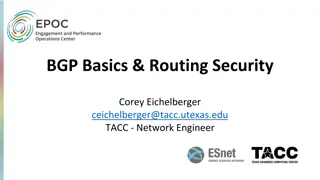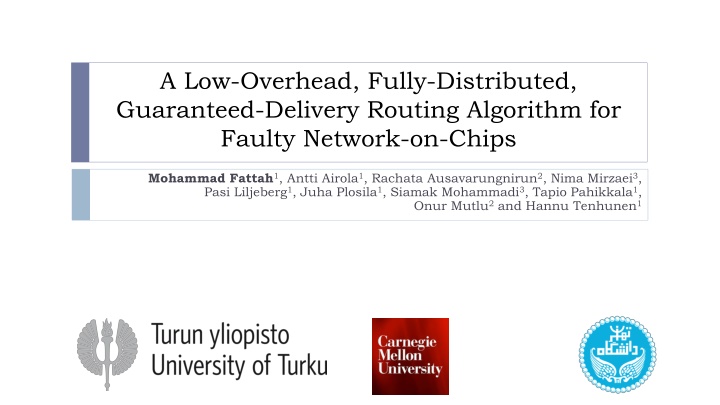
Efficient Fault-Tolerant Routing Algorithm for Network-on-Chips
Explore a low-overhead, fully-distributed routing algorithm - Maze-Routing for faulty Network-on-Chips. Overcoming limitations of previous methods, it ensures guaranteed delivery, dynamic fault detection, and better performance with reduced area overhead and reconfiguration time.
Download Presentation

Please find below an Image/Link to download the presentation.
The content on the website is provided AS IS for your information and personal use only. It may not be sold, licensed, or shared on other websites without obtaining consent from the author. If you encounter any issues during the download, it is possible that the publisher has removed the file from their server.
You are allowed to download the files provided on this website for personal or commercial use, subject to the condition that they are used lawfully. All files are the property of their respective owners.
The content on the website is provided AS IS for your information and personal use only. It may not be sold, licensed, or shared on other websites without obtaining consent from the author.
E N D
Presentation Transcript
A Low-Overhead, Fully-Distributed, Guaranteed-Delivery Routing Algorithm for Faulty Network-on-Chips Mohammad Fattah1, Antti Airola1, Rachata Ausavarungnirun2, Nima Mirzaei3, Pasi Liljeberg1, Juha Plosila1, Siamak Mohammadi3, Tapio Pahikkala1, Onur Mutlu2and Hannu Tenhunen1
What is This Talk About? Overtime, routers and links can become faulty. Any # of faults Dynamically find alternative paths. Detect partitioning Previous works have at least one of the following limitations: Cover only few number of faults Use a central controller High area overhead High reconfiguration overhead upon new faults No central component No routing table Maze-Routing overcomes all the above limitations: Full-coverage: formally proven Fully-distributed: using autonomous and standalone routers Low area overhead: using an algorithmic approach (16X less area compared to routing tables) Low reconfiguration overhead: by on the fly path exploration (Instantaneous operation on new failures) Better performance: 50% higher saturation throughput and, 28% lower latency on SPEC benchmarks compared to state-of-the-art No reconfiguration phase Source: condenaststore.com 2
Aggressive Transistor Scaling Key Benefit A Major Curse Integrating many IPs Processors Cache slices Memory controllers Specialized HW Etc. Reduced reliability Fabrication time: Defect Process variation Run-time: Negative bias temperature instability (NBTI) Hot carrier injection (HCI) Gate oxide breakdown Electro-Migration Our designs must be: Fault-tolerant by construction! 3
IP vs. Network Faults IP Degrades the performance Rest of the system can continue Network Elements Cripples the performance Single point of failure It is crucial to tolerate Many faults in links and routers! 4
Maze-Routing Fault-Tolerant by Construction Four Critical Goals It is not: A router architecture, with fault tolerance patched to it Full coverage (guaranteed delivery) Fully-distributed operation Maze-Routing is The first to provide all! Rather, it is Essentially a routing algorithm, which Is inherently fault-tolerant Low area footprint No reconfiguration component/phase North North XY XY XY XY Maze XYX East Priority Arbiter East Maze South South Maze West West Maze Local Local Maze 5
Our 4 Goals Maze-Routing - Full coverage - Full distribution - Low area cost - Fast adaptation Results - Finding the path - Area - Throughput - Reconfiguration overhead - Detecting disconnected nodes 6
Our 4 Goals - Full coverage - Full distribution - Low area cost - Fast adaptation 7
Goal 1: Full (Fault) Coverage Literature Maze-Routing No restriction on Fault count Fault pattern Limited number of faults Detect disconnected nodes At router level Limited fault pattern Limited when disconnected nodes 8
Goal 2: Fully Distributed Operation Literature Maze-Routing No central component No reconfiguration unit Each router makes individual decisions Faults in algorithm only disables the associated links Centralized methods Single point of failure TMR: Expensive North North Maze Priority Arbiter East East X Maze South South Maze West West Maze Distributed methods Synchronization points. Fault in Reconf. unit. Local Local Maze Reconf. Reconf. Reconf. Reconf. Cent. SW/HW Controller Reconf. Reconf. Reconf. Reconf. Reconf. Reconf. Reconf. Reconf. Reconf. Reconf. Reconf. Reconf. 9
Goal 3: Low Area Overhead Literature Maze-Routing Routing tables High area overhead 5 read ports An algorithmic approach No routing table Implementation cost Power dissipation Vulnerability to run-time faults One failed bit: affects the whole router Area ~ fault probability of router 10
Goal 4: Low Reconfiguration Overhead Literature Maze-Routing New failure detected? 1) Pause the network 2) Reconfigure to an alternative solution 3) Resume normal operation No reconfiguration phase Path to destination is dynamically calculated per packet Issues? Severe degradation of performance aggressive online testing Called on the fly reconfiguration Few works with fast reconfiguration 11
Maze-Routing: The First to Provide All Coverage Reconfiguration O(Area) few fully distributed moderate central moderate central moderate central moderate distributed moderate distributed high central O(Reconf.) on the fly N/A N/A moderate fast fast N/A Zhang et al. [43] LBDR [35] d2-LBDR [7] OSR-Lite [38] TOSR [5] BLINC [25] uLBDR [36] Wachter et al. [39] Fick et al. [19] Face routing [11] FTDR-H [18] uDIREC [32] ARIADNE [3] Maze-routing low low low low high high high high high high high full full full distributed distributed fully distributed fully distributed central distributed fully distributed high high excessive high high high low slow slow on the fly fast excessive slow on the fly 12
Our 4 Goals Maze-Routing - Full coverage - Full distribution - Low area cost - Fast adaptation - Finding the path - Detecting disconnected nodes 13
Preliminaries Face: regions bounded by links and routers 4 inner faces 1 outer face Right/Left hand rule: exit from first output in right/left side. : clockwise around inner faces : counterclockwise around inner faces Opposite direction around outer faces 14
Preliminaries (II) Few additional fields in the header 1. MDbest : closest distance (MD) to dst that the packet has reached so far Initial: MDsrc, dst Only decrements Mode: routing mode used for the packet Values: normal, traversal ( or ), unreachable Initial: normal 2. 2 more fields to detect disconnected nodes 15
Maze-Routing Normal mode: Is there any productive output? Take it and dec(MDbest) No? we should enter traversal mode: Draw line(cur, dst)between current node and dst ? Take the first output in the left of line(cur, dst) ? Take the first output in the right of line(cur, dst) Set the mode (either or ), accordingly 1 N 2 N 4 3 2 1 3 0 N 3 1 Maze-Routing definitely reaches dst, if a path to dst exists. dst 3 N We provide the formal proof in the paper. 4 3 2 1 4 N Traversal mode: If MDcur, dst= MDbest with productive output? Return to (and act as in) normal mode Otherwise, follow the hand rule 5 4 3 2 src 5 N 16
Detecting Disconnected Nodes Traversal mode: If MDcur, dst= MDbest with productive output? Return to normal mode No? Follow the hand rule 2 1 2 3 1 1 1 2 dst 1 N More implementation details are available in the paper The destination is unreachable if: In traversal mode, we meet the same node as the one we entered the traversal mode 2 1 2 3 The hand rule picks the same output as when we entered the traversal mode 3 2 3 4 src 3 N 17
Our 4 Goals Maze-Routing - Full coverage - Full distribution - Low area cost - Fast adaptation Results - Finding the path - Area - Throughput - Reconfiguration overhead - Detecting disconnected nodes 18
Simulation Methodology NOCulator[1] 8x8 mesh for performance analysis Synthetic traffic for performance evaluation SPEC CPU2006 benchmarks are also evaluated Maze-Routing[2] implanted in minBD[3] routers Deflection-based: deadlock freedom Golden and sliver flits: router-level livelock freedom Retransmit-once: protocol-level deadlock freedom [1] NOCulator: https://github.com/CMU-SAFARI/NOCulator [2] Maze-Routing: https://github.com/CMU-SAFARI/NOCulator/tree/Maze-routing [3] MinBD: Fallin, Chris, et al. "MinBD: Minimally-buffered deflection routing for energy-efficient interconnect." NoCS 2012. 19
Configurations Maze-Routing 16 buffer spaces per (minBD) router Base-line router Wormhole buffered routers 1 VC per port 40 buffer spaces per router Faults: Links disabled randomly From 1 to 5 link failures 20
Workloads Synthetic traffic Uniform random traffic with variant injection rates SPEC CPU2006 benchmarks Grouped based on L1 misses per kilo instruction (MPKI) 3 groups: High (>50), Low (<5), and Medium (rest) intensity 4 mixes: L (all Low), ML (Medium/Low), M (all Medium), and H (all High). 21
Area Overhead STMicro 60nm technology node 8x8 16x16 50 100 45 Maze-routing: 5 copies of alg., 1 per port 40 35 ARIADNE: Smallest table Reconfiguration logic is not implemented 5 read ports 15.9 x area ( m2) 30 3.8 x 25 20 15 27% LBDRe: Logic-based method Central approach Limited coverage 10 2.1 x 239.21 11.84 15.05 44.71 5 5.68 6.06 0 Maze-routing ARIADNE LBDRe 22
Throughput: Uniform Random Traffic 1 disabled link 5 disabled links Maze-routing up*/down* Maze-routing up*/down* 21 21 Provided path divergence Average flit latency (cycles) Average flit latency (cycles) 50% 20 20 19 19 18 18 Sub-optimal paths 17 17 16 16 0 0.04 Injection rate (flits/node/cycle) 0.08 0.12 0.16 0.2 0.24 0.28 0 0.04 0.08 0.12 0.16 0.2 0.24 0.28 Injection rate (flits/node/cycle) 23
Throughput: SPEC CPU Average packet latency Up*/Down* Maze-routing workload mix L ML M H AVG 5 failures no failure 5 failures no failure 16.7 18.8 27.7 54.4 29.4 16.4 18.2 25.7 50.5 27.7 17.8 18.9 21.6 25.8 21 16.4 17.2 19.2 23.1 19 30% latency reduction in average case 24
Reconfiguration Overhead ARIADNE Maze-routing 19 66K Cycles 40K Cycles Average Latency (cycles) 18 0.2 flits/node/cycle 17 Maze-Routing has no reconfiguration phase 16 15 20 25 30 35 40 45 50 Time ( 104 cycle) 25
Summary A practical fault-tolerant routing algorithm must Provide full coverage with guaranteed delivery Operate in fully-distributed manner Impose low area overhead Have low reconfiguration overhead Maze-Routing is the first work to meet all the above goals NOCulator and Maze-Routing are available on GitHub https://github.com/CMU-SAFARI/NOCulator https://github.com/CMU-SAFARI/NOCulator/tree/Maze-routing 26
A Low-Overhead, Fully-Distributed, Guaranteed-Delivery Routing Algorithm for Faulty Network-on-Chips Mohammad Fattah1, Antti Airola1, Rachata Ausavarungnirun2, Nima Mirzaei3, Pasi Liljeberg1, Juha Plosila1, Siamak Mohammadi3, Tapio Pahikkala1, Onur Mutlu2 and Hannu Tenhunen1
Area Overhead Header fields can be coded in 14/17 bits in 8x8/16x16 meshes. Assuming a baseline router with 144-bit channel width, we need to widen the channel by 10%/12%. Results in almost 20%/25% increase in the router area. 29
Deflection Implications When a packet is deflected Header values are not valid anymore 4 3 2 1 3 We need to reset the header values: Mode Normal MDbest MD (next router, dst) 3 1 dst 4 3 2 1 5 4 3 2 src 30
Delivery Proof Property: Given there is a path between src and dst, starting from src, by traversing the face underlying line(src,dst), the packet will definitely intersect the line at some point (p) other than src 4 3 2 1 3 1 dst The MD(p,dst) is definitely smaller than MD(src,dst). 4 3 2 1 In traversal mode: If MDcur, dst= MDbest with productive output? Return to (and act as in) normal mode 5 4 3 2 we definitely exit to normal mode src 31
A Low-Overhead, Fully-Distributed, Guaranteed-Delivery Routing Algorithm for Faulty Network-on-Chips Mohammad Fattah1, Antti Airola1, Rachata Ausavarungnirun2, Nima Mirzaei3, Pasi Liljeberg1, Juha Plosila1, Siamak Mohammadi3, Tapio Pahikkala1, Onur Mutlu2 and Hannu Tenhunen1

